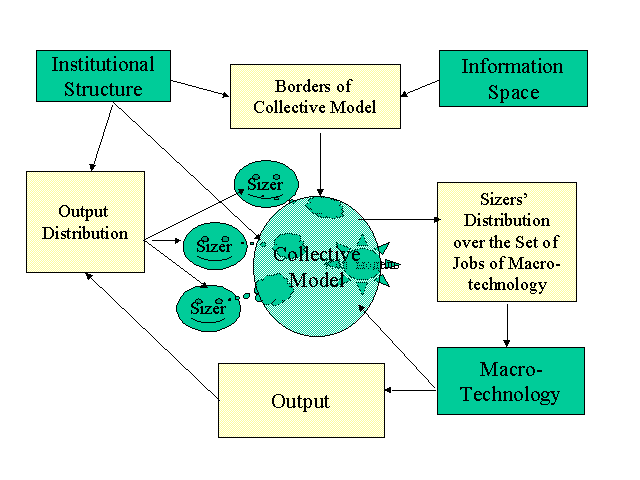
8. Economy as a complex system of agents with information interactions
In all cases before we understood the term "agent" as a human who is an actor of social processes. Now we should make the sense of the term a little wider because we are going to rewrite our scheme of information interactions under the "agent-based computational economics" method (Leigh Tesfatsion; Philip E. Agre).
According contents of previous sections we will describe "interactions of autonomous agents channeled through socio-economic institutions" (Leigh Tesfatsion) where types of agents include following:
1) Macro-technology;
2) Information space;
3) Institutional structure;
4) Collective information model of environment;
5) Human participant of interactions (he is an "agent" in narrow sense of this term).
From our point of view each of these five agents has much or less human component because they functioning realize through certain human activity. So when we define five types of agents here we distinguish some kind of specific human activity related with each of the agents.
To be more precise in terms let the fifth type of agents ("human participant") will be called as a "sizer". The same name has some similar models of self-replicated objects from mathematical genetics. See a survey on "self-replication" topics in (Moshe Sipper).
Summarize all above we can define the main functions and features of selected five types of agents ("what these agents produce in the system"). At the first step of building an agent-based model of the complex socio-economic system in the framework of our methodology we, of course, make some simplifications:
1. "Macro-technology" agent produces a resource for sizers' living. The quantity of the resource depends on parameters of sizers' distribution over the set of jobs belonged to the macro-technology. Sizers' optimizing behavior that looks in our case as their wish to find the best distribution leads the whole system of agents to an equilibrium state. In principal the system can have several parallel macro-technology agents.
2. "Information space" agent produces for each sizer in the system a perimeter of the zone of his environment where he can recognize a sub-set of sizers for interactions (choice area). The boundaries of the choice area depend on the ICT development level and on the strength of changes in the system (including sizers' states). So then more steady stable state sizers have then in average their choice area is wider. This agent makes local a sizer's searching of optimal distribution over the set of jobs. In general the system has only one agent of this type.
3. "Institutional structure" agent produces a sub-space for sizers interactions. Such sub-space defines rules of sizers' information images building and makes a certain simple projection of macro-technology set of jobs. By this way sizers can get wider choice areas from the "information space" agent and in result they have more chances to find their optimal distribution over the set of jobs. The system can have several agents of this type.
4. "Collective information model" agent produces the best (and Pareto optimal) plan for changing current configuration of sizers' distribution over the set of jobs. It works similar to "how agents are learning about other agents" (Jose M. Vidal, Edmund H. Durfee). This agent appears for each group of sizers those "see" each other in their choice areas. The same picture takes place for each parallel sub-space created by "institutional structure" agents. Sizers exchange through the collective model by their suggestions on re-configuration of current distribution over jobs. The best (by output) suggestion registered in the collective model to the end of time for sizers' "discussions" becomes a real configuration of jobs distribution for the next production cycle.
5. "Sizer" agent produces the maximum of his output by changing his place in the macro-technology chain. He can also initiate the same changes for other sizers from his choice area. His suggestions will produce the real growth of his output if it approved by other sizers from his choice area (criterion is Pareto optimum). He can choose different sub-spaces to "discuss" with other sizers of the system how they can get a better output. The system can have many agents of this type.
General relations between these types of agents see at the Fig. 8.

Fig. 8.
Green boxes on the Fig. 8 mean types of agents. Yellow boxes – intermediate objects of the system that help to show relations between agents. As one can see on the Fig.8 the central element of the system is the "collective information model" agent. A set of these agents provides the main process of the system functioning (information interactions between sizers) and reflects current states of macro-technology, institutional structures and sizers themselves. The "information space" agent specifies the precision of this reflection and its boundaries.
More detailed working out of the model should be plunged into a framework of the appropriate modeling method. It could be well-known SWARM method (http://www.soc.surrey.ac.uk/JASSS/1/2/4.html) or more mathematically well-developed TAO (http://www.rriai.org.ru/TAO/).
Next section - Conclusion
Previous section - 7. General picture of economic system functioning through information interactions